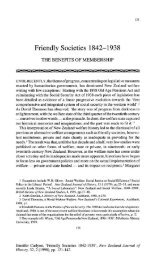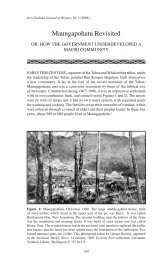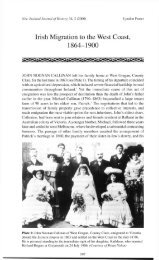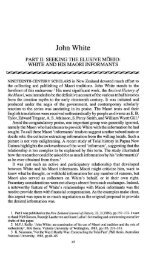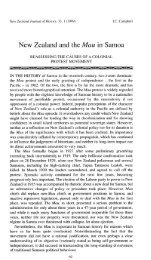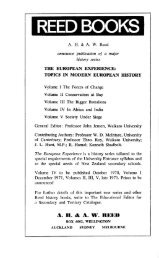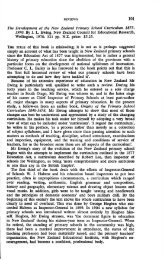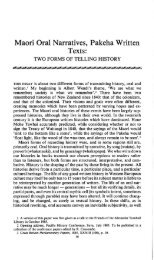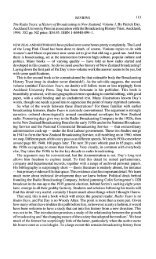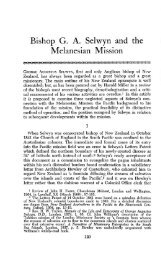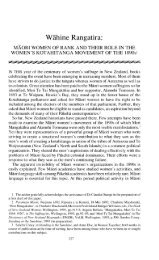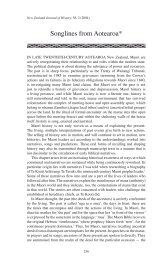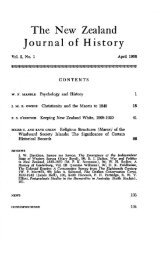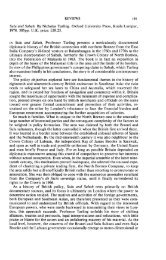Songlines from Aotearoa* - New Zealand Journal of History
Songlines from Aotearoa* - New Zealand Journal of History
Songlines from Aotearoa* - New Zealand Journal of History
You also want an ePaper? Increase the reach of your titles
YUMPU automatically turns print PDFs into web optimized ePapers that Google loves.
SONGLINES FROM AOTEAROA 265<br />
Maungapohatu, Aperira 12th 1906<br />
I tena ra ka whakaaturia; i [te] 25 o Hune haere au ki runga i te torona, ka tae mai a te<br />
kiingi ki Turanga.<br />
Maungapohatu, April 12th 1906<br />
On that day it was revealed; on June 25th I will ascend the throne, the king will arrive<br />
at Turanga [Gisborne]. 37<br />
This pilgrimage was reported by journalists and photographed for the Auckland<br />
Weekly <strong>New</strong>s. 38 The latent meaning <strong>of</strong> the, journey was then ascribed by Rua’s<br />
followers: instead <strong>of</strong> King Edward, who did not come to Gisborne, it was Rua<br />
who was properly king. It was a claim to sovereignty.<br />
Rua’s continuing relationship with Whaitiri extended at least into the late<br />
1920s. Whaitiri’s appearance was identified, in the Tawhaki myth cycle, by her<br />
unique perfume. 39 Heta Rua described Whaitiri’s presence, <strong>of</strong>ten experienced<br />
at Maungapohatu, in the same way:<br />
The only time you can notice her is she has a beautiful perfume. When Rua was passing<br />
you, you’d be trying to follow where it comes <strong>from</strong>. Well, it’s on him. That’s the only<br />
time you know that lady is there somewhere . . . . Once you get that perfume, she is<br />
there all right. That’s the only time when that lady appeared, when there’s a church<br />
service, or when he was going up to the pä in Maungapöhatuhe’s going ahead <strong>of</strong> you,<br />
then you get that perfume smell. It comes on the wind and you wonder where it is<br />
coming <strong>from</strong>. So that lady must be there, looking after somebody. 40<br />
Another ancestral figure with whom Rua identified was the sea-creature Te<br />
Tahi-o-Te-Rangi, who became famous for his saying that, rather than destroy<br />
people in revenge, ‘Waiho ma te whakama e patu. Waiho hai korero i a tatau<br />
kia atawhai ki te iwi/Leave them for shame to punish. Let us acquire fame<br />
by means <strong>of</strong> mercy.’ 41 Te Tahi appears on the porch <strong>of</strong> the carved house built<br />
by Tuhoe for Te Kooti, Te Whai-a-te-motu (The Pursuit-across-the-land). Te<br />
Kooti opened this house in 1891, and there could be little doubt that Rua was<br />
among the large gathering assembled to discuss the future <strong>of</strong> Tuhoe’s land.<br />
This principle <strong>of</strong> mercy, or tolerance, for which Te Tahi-o-Te-Rangi was<br />
remembered, Te Kooti had taken as his own when he eschewed war <strong>from</strong> 1873.<br />
Rua, in his turn, used his Tuhoe ancestral figure as his charter (or guide) when<br />
he adopted Te Kooti’s principle <strong>of</strong> maungarongo, lasting peace, and he had Te<br />
Tahi’s name stitched onto one <strong>of</strong> the flags he flew at Maungapohatu.<br />
There is, <strong>of</strong> course, another set <strong>of</strong> templates that all the Maori nineteenthcentury<br />
leaders applied to their own situation: the scriptural texts and stories.<br />
Maori internalized the redemptive messages <strong>of</strong> the Scriptures, as they<br />
identified with the genealogically structured, orally composed narratives <strong>of</strong><br />
the Bible, the Israelitic tribal traditions <strong>of</strong> journeying, and the Jewish history<br />
<strong>of</strong> dispossession. The identification strengthened rather than weakened as the<br />
situational parallels grew, once the confiscation <strong>of</strong> land was rammed through<br />
in all the regions where war was fomented by government actions <strong>from</strong> 1863.<br />
Each <strong>of</strong> the Maori prophet leaders saw themselves as Moses. Encoded in<br />
this identification is the premise that another leader would rise to fulfil the<br />
quest <strong>of</strong> Moses: to return the people to their homeland and to their autonomy.



